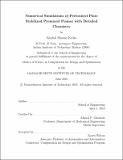| dc.contributor.advisor | Ahmed F. Ghoniem. | en_US |
| dc.contributor.author | Kedia, Kushal Sharad | en_US |
| dc.contributor.other | Massachusetts Institute of Technology. Computation for Design and Optimization Program. | en_US |
| dc.date.accessioned | 2011-03-24T18:53:09Z | |
| dc.date.available | 2011-03-24T18:53:09Z | |
| dc.date.copyright | 2010 | en_US |
| dc.date.issued | 2010 | en_US |
| dc.identifier.uri | http://hdl.handle.net/1721.1/61793 | |
| dc.description | Thesis (S.M.)--Massachusetts Institute of Technology, Computation for Design and Optimization Program, 2010. | en_US |
| dc.description | This electronic version was submitted by the student author. The certified thesis is available in the Institute Archives and Special Collections. | en_US |
| dc.description | Cataloged from student-submitted PDF version of thesis. | en_US |
| dc.description | Includes bibliographical references (p. 83-86). | en_US |
| dc.description.abstract | The objective of this work is to develop a high efficiency two-dimensional reactive flow solver to investigate perforated-plate stabilized laminar premixed flames. The developed code is used to examine the impact of the operating conditions and the perforated plate design on the steady flame characteristics. It is also used to numerically investigate the response of these flames to imposed inlet velocity perturbations. The two-dimensional simulations are performed using a reduced chemical kinetics mechanism for methane-air combustion, consisting of 20 species and 79 reactions. Heat exchange is allowed between the gas mixture and the solid plate. The physical model is based on a zero-Mach-number formulation of the axi-symmetric compressible conservation equations. The steady results suggest that the flame consumption speed, the flame structure, and the flame surface area depend significantly on the equivalence ratio, mean inlet velocity, the distance between the perforated plate holes and the plate thermal conductivity. In the case of an adiabatic plate, a conical flame is formed, anchored near the corner of the hole. When the heat exchange between the mixture and the plate is finite, the flame acquires a Gaussian shape stabilizing at a stand-off distance, that grows with the plate conductivity. The flame tip is negatively curved; i.e. concave with respect to the reactants. Downstream of the plate, the flame base is positively curved; i.e. convex with respect to the reactants, stabilizing above a stagnation region established between neighboring holes. As the plate's thermal conductivity increases, the heat flux to the plate decreases, lowering its top surface temperature. As the equivalence ratio increases, the flame moves closer to the plate, raising its temperature, and lowering the flame stand-off distance. As the mean inlet velocity increases, the flame stabilizes further downstream, the flame tip becomes sharper, hence raising the burning rate at that location. The curvature of the flame base depends on the distance between the neighboring holes; and the flame there is characterized by high concentration of intermediates, like carbon monoxide. To investigate flame dynamics, linear transfer functions, for low mean inlet velocity oscillations, are analyzed for different equivalence ratio, mean inlet velocity, plate thermal conductivity and distance between adjacent holes. The oscillations of the heat exchange rate at the top of the burner surface plays a critical role in driving the growth of the perturbations over a wide range of conditions, including resonance. The flame response to the perturbations at its base takes the form of consumption speed oscillations in this region. Flame stand-off distance increases/decreases when the flame-wall interaction strengthens/weakens, impacting the overall dynamics of the heat release. The convective lag between the perturbations and the flame base response govern the phase of heat release rate oscillations. There is an additional convective lag between the perturbations at the flame base and the flame tip which has a weaker impact on the heat release rate oscillations. At higher frequencies, the flame-wall interaction is weaker and the heat release oscillations are driven by the flame area oscillations. The response of the flame to higher amplitude oscillations are used to gain further insight into the mechanisms. Key words: Laminar premixed flames, perforated-plate stabilized flames, flame-wall interactions, flame consumption speed, stand-off distance. | en_US |
| dc.description.statementofresponsibility | by Kushal Sharad Kedia. | en_US |
| dc.format.extent | 87 p. | en_US |
| dc.language.iso | eng | en_US |
| dc.publisher | Massachusetts Institute of Technology | en_US |
| dc.rights | M.I.T. theses are protected by
copyright. They may be viewed from this source for any purpose, but
reproduction or distribution in any format is prohibited without written
permission. See provided URL for inquiries about permission. | en_US |
| dc.rights.uri | http://dspace.mit.edu/handle/1721.1/7582 | en_US |
| dc.subject | Computation for Design and Optimization Program. | en_US |
| dc.title | Numerical simulations of perforated plate stabilized premixed flames with detailed chemistry | en_US |
| dc.type | Thesis | en_US |
| dc.description.degree | S.M. | en_US |
| dc.contributor.department | Massachusetts Institute of Technology. Computation for Design and Optimization Program | |
| dc.identifier.oclc | 706804939 | en_US |
